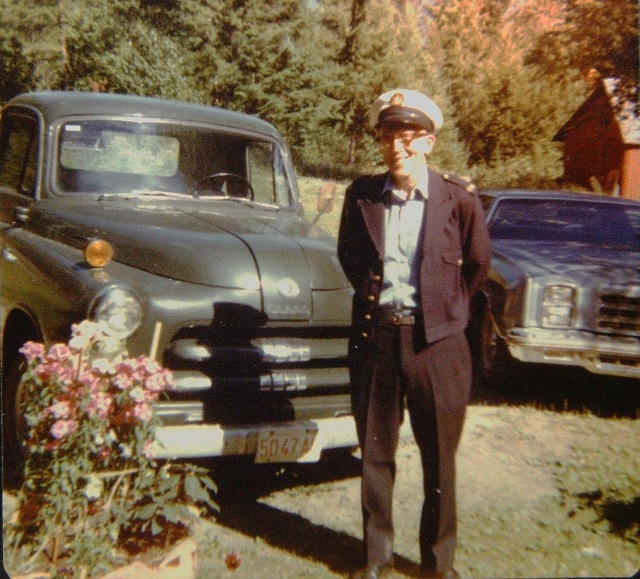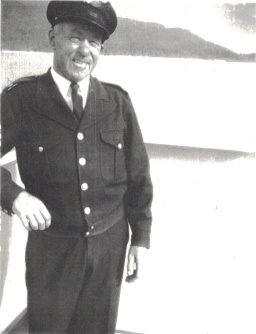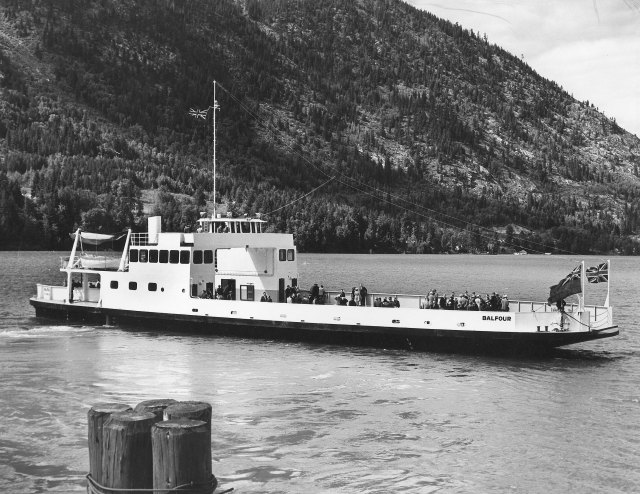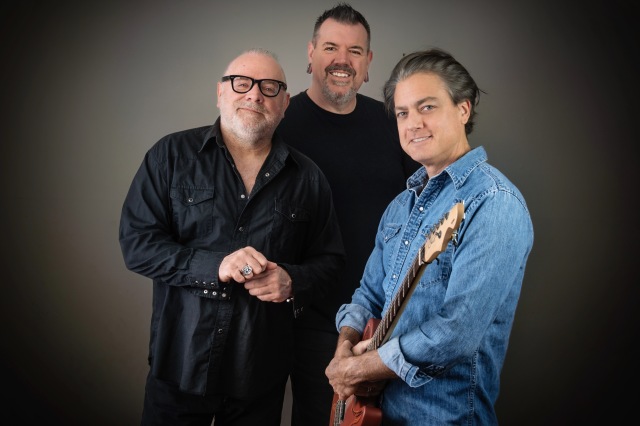A review of Connecting the Kootenays: The Kootenay Lake Ferries, by Michael A. Cone, non-fiction/regional history, 2022.
For thousands of years prior to the building of the Roman roads, humanity’s highways were rivers, lakes, oceans and seas. It simply made more sense—it was faster and less labour intensive to sail a craft along known water routes. Well before the Age of Exploration, when sailing ships finally broke the barriers of the Atlantic and Pacific oceans, people in ancient times were maintaining extensive trading networks from the Mediterranean to the Orkney islands of northern Scotland. Cobalt glass beads found in Scandinavian Bronze Age tombs reveal trade connections between Egypt and Nordic countries 3,400 years ago.[1]
So it’s no surprise that during the European settlement of the Kootenays the primary mode of travel was by water. This made eminent sense given the steeply mountainous terrain, and indeed, the region’s Indigenous peoples—the Ktunaxa and Sinixt—had already been navigating Kootenay waterways for thousands of years by canoe. Explorer David Thompson first charted the region in the late 18th century from the seat of a canoe with the help of Indigenous guides. Then, with the advent of the steamship era, the lakes and some of the rivers of the Kootenays were traversed by humble steam tugs and the more majestic sternwheelers, cruising at a gentle speed. For settlers living along the shorelines of Kootenay Lake, their only communication and supply line to the outside world came from these steam-powered craft. Lake dwellers would put up an agreed-upon signal on the beach and the shallow-draft steamboats would land to pick up or deliver mail and supplies. You can imagine the excitement of seeing one of these gleaming white structures—some of them with three or more decks topped with the wheelhouse—arrive on your lonely stretch of graveled shoreline.

The Nasookin, queen of the Kootenay Lake fleet during the heyday of steamboat operations dominated by the CPR, approaching Procter on her morning run to Kootenay Landing. Image courtesy Michael A. Cone
Until the invention of the automobile and the profound transformation it wrought on transportation networks, Kootenay roads were little more than glorified pack trails—impassable to all but the hardiest of souls. Sadly, the impetus given to building proper roads and linking them all together provided by the automobile would spell the end of the noble steamboat era on Kootenay Lake. There was a brief crossover period during which the old steamboats such as the Nasookin—once practically a floating four-star hotel—were repurposed as car ferries. If you were a Greyhound bus driver during the 1930s and ’40s it would have taken a great deal of stamina to watch as your bus was chained across the bow of the Nasookin for the crossing from Gray Creek to Fraser’s Landing near Balfour. During a storm Kootenay Lake can be as dangerous as the sea. But as the price of automobiles became more affordable to the average family, car traffic exploded and a new and better kind of ferry had to be sought.
Michael A. Cone has done a superb job of chronicling the history of Kootenay Lake ferries, leading us from the crossover era through a century of ferry service up to the present with the state-of-the-art Osprey, launched in 2000. This is a beautifully put together and well-written book. The large, colour format of Connecting the Kootenays is a visual treat and its wealth of historical photographs help the reader chart their way through the chronology of the ferries, even what to the untrained eye would be subtle alterations to, for example, the Nasookin and the more modern Anscomb. Having researched and written two books of regional history and one of national history, I can attest to the work that goes into sourcing historical images, quite apart from the often-daunting task of composing the text.

Provincial Government ferry Anscomb making her approach to the Balfour wharf circa 1956. It would faithfully serve Kootenay Lake residents until its replacement in 2000 by the Osprey. Photograph courtesy of Michael A. Cone.
Like the best histories, the book transports you back in time, giving you an almost palpable sense of what it would have been like to ride on a sternwheeler cutting through the waves of Kootenay Lake. The reader learns a lot about the operations of steamboats and ferries, especially the critical roles played by deckhands in assuring safe passage across this mercurial inland sea. Even though I grew up with two grandfathers who worked on the Kootenay Lake ferries—Roy Fisher, who worked as a relief captain on the Anscomb, and Herb Brown, an engineer on both the Balfour and the Anscomb—like most people I took for granted the work done by ferry staff, with little conception of the vital functions they fulfill. What may seem a simpleton’s job—guiding vehicles onto the ferry deck—is in fact an important way of creating stability for the vessel by ensuring the greatest weight is kept over the ferry’s centre of gravity. These skilled crews are a literal lifeline when things go wrong.

Herb Brown on the day of his last shift on the Kootenay Lake ferries, 1976. Image courtesy Joyce archives
On a personal note, it was great to see Herb Brown repeatedly cited throughout the text for his contributions. One has to remember that Brown was a farm boy who never finished high school, raised in Alberta during the “dust bowl” conditions of the Great Depression. Yet due to an innate genius for mechanics, he was able to work his way up from dock labourer and deckhand to engineer. In fact, as Cone writes, some of Brown’s mechanical innovations not only improved the Balfour’s efficiency but lasted decades without needing major repair. Cone also relates the incident Herb used to tell me about when I was a boy—the exciting tale of the day the ferry was blown far off course on Kootenay Lake and he had to rush up from the engineering deck to help steer the ferry back on course. From Herb’s beaming countenance in some of the photos in this book, it’s clear that this was a man doing exactly what he was born to do in life.

Roy Fisher, who served as relief captain on the Kootenay Lake ferries from 1964–1970. Image courtesy Joyce family archives
It’s unfortunate that Cone had not heard of Roy Fisher, who served as relief captain on the Kootenay Lake ferries from 1964–1970. But there’s always the second edition! Fisher earned his qualifications at Vancouver, serving on a passenger freighter called the Princess Patricia that ran north to Dutch Harbor in the Alaska islands chain. After qualifying as steamship master, he joined the Kootenay Lake fleet, first serving as relief captain on the Anscomb. Roy was an affable, gregarious personality who relished the look on children’s faces when they were allowed to come up from the car deck to ‘steer’ the ferry. I remember being one of those kids, maybe five or six years old, breathless with wonder at the man in his brass buttoned uniform and peaked cap, as I hung on for dear life to the wheel with its seemingly endless spokes.

The launching of the new auxiliary ferry Balfour at the CPR’s Nelson shipyard, June 25, 1954. Photograph courtesy of Touchstones Nelson Museum of Art and History.
Cone’s book is highly recommended for anyone with an interest in West Kootenay history or steamboat history generally. Just as the Mississippi had its classic era of the sternwheel-driven riverboats, we had our graceful era of steamboat travel in Western Canada. And it’s a reminder that newer is not always better where technology is concerned. I for one would far rather have been living in the classic age of the Kootenay Lake sternwheeler, riding from Nelson to Kaslo on the Moyie, leaning over the railings as the miles ticked lazily past with the froth, or having a four-course dinner in the luxurious dining room on the Kuskanook. Newer ferry technologies are probably safer and certainly faster, but they will never recapitulate the old world elegance and class of these steam-powered vessels that were a literal lifeline to Kootenay Lake residents prior to the development of public highways.
[1] Philippe Bostrom, “Beads Found in 3,400-year-old Nordic Graves Were Made by King Tut’s Glassmaker,” March 9, 2016: https://oldnorse.org/2020/11/17/beads-found-in-3400-year-old-nordic-graves-were-made-by-king-tuts-glassmaker/



Joyce Celebrates Release of Words from the Dead
I’m proud to announce the publication of my tenth book, Words from the Dead: Relevant Readings in the Covid Age, published by Ekstasis Editions of Victoria, BC Canada.[1] My body of published work now includes poetry, a novel, Western Canadian history, and this latest book, a collection of essays.[2] My method in Words from the Dead is to analyze the Covid Age through great works of literature, poetry and history, using them as a lens through which to focus critical thinking. Art is far more than mere entertainment, or some enjoyable but unnecessary frill. Even popular culture such as songs and movies—to the extent it relies on the great themes of art—can be a source of deep meaning. History itself began from the storytelling impulse, the basis of narrative. The greatest historians, in my view, are those that instruct us in the principle of pattern recognition over vast spans of time and human behaviour. Essays are simply a more direct way of critically addressing the stories we tell each other in a culture. And it’s clear that now more than ever, the narratives we hear in the media are in need of challenging. I preface the book with several quotes, among them one from investigative journalist Eva Bartlett, who said that “the media exists to sell narratives, not to tell the truth.”
I certainly debunk the scientific and social fallacies at work during Covid lockdowns, supported by more than 600 footnotes and references from credible sources. But rather than merely telling readers what to think, the goal is to teach the basics of critical thinking and Socratic reasoning. The intellectual principle is based on the familiar adage: “If you give a man a fish, you feed him for a day. If you teach him how to fish, you feed him for a lifetime.”
Words from the Dead cover from Ekstasis Editions (2022)
Artists and writers often seem to have a direct line to what Carl Jung called the “collective unconscious,” or what others have dubbed the “zeitgeist” of a civilization, meaning roughly “the spirit of the age.” In that respect they fulfill what Beat poet Allen Ginsberg called the “vatic” role as seers and thus fit into a continuity with religious mystics and prophets over the centuries. Not that writers necessarily have the capacity to predict specific events, but rather, they have an intuitive grasp of human nature and the ability to synthesize a wide-ranging array of information into a coherent whole. As I argue in my essay “Apocalypso,” which examines the symbolism in the Bible book of Revelation, the apostle John was essentially filling this role. His fine-grained and at times hallucinogenic visions could apply to almost any period of social collapse. As Jung would argue, he like most poets is speaking in archetypes, not specific political details. This frees us from having to debate whether such Bibical passages are “true” or not and benefit by their insights into broad principles of human existence. The same could be said of almost any work of literature.
Words from the Dead counters the recent (and shallow) conceit that we have nothing to learn from the so-called “dead white males” of literary history. Literary critic and scholar Harold Bloom was saw this political agenda coming way back in the early 1990s when he published his book The Western Canon. “Pragmatically, the ‘expansion of the Canon’ has meant the destruction of the Canon, since what is being taught includes by no means the best writers… but rather the writers who offer little but the resentment they have developed as part of their sense of identity.”[3] Even some academics are growing tired of this rhetoric, for example Roosevelt Montás, a senior lecturer in American studies and English at Columbia University and the daughter of immigrants from the Dominican Republic. She writes of her liberal education fostering a sensitivity to “a culturally influential critique of ‘the canon’ that insists that Homer, Sophocles, Plato, Montaigne, Cervantes, Goethe, Hegel, Dostoyevsky, Woolf, et al, are not for people like me, that they are for white people, or rich people, or people born with class privileges that I lacked.”[4] Yet she recalls the seminal moment that crystallized her desire to become a literary scholar—when she discovered Socrates: “I did not need to be rich, privileged or cultured to find in those words something that spoke to the deepest sense of my own being. And I did not need to be white or European to be startled by the claim that ‘the unexamined life is not worth living’.” As Bloom writes, “history is more than the history of class struggle, or of racial oppression, or of gender tyranny.”[5] As Montás discovered to her delight, what makes some works of literature and art perpetual is their capacity to speak to people everywhere in the most profound terms. Art is a mirror we hold up to ourselves and society, the “examined life” Socrates urged that reveals new dimensions to our existence in this world. As far as I’m concerned, the best art has no gender, no race, no nationality.
Words from the Dead provides a critical analysis of our times that draws on a reading list of nearly 50 books, spanning a historical timeline from the 5th century BC to the present. From the ancient Taoist sages Lao Tzu and Chuang Tzu, through the writers of immortal literature, to more recent critical commentators such as Karl Popper, Arnold Toynbee, John Ralston Saul and Michael Rectenwald, Words From the Dead digs deep for its perspectives. From the 1872 utopian novel Erewhon (“nowhere” spelled backwards) by Samuel Butler to the pop culture genius of the classic 1960s TV series The Prisoner, the hit series Star Trek: The Next Generation, and the socially incisive lyrics of British folk-rock songwriter Roy Harper, this book explores the common threads that unite great art in many of its forms. As Professor Emeritus of English Literature Roger C. Lewis wrote in his review of my poetry collection Diary of a Pandemic Year, “against this imagery of apocalyptic punishment… the poet sets over a mythical construct of what Northrop Frye called ‘the assumption of total coherence…’”[6]
As an essayist I’m following in the tradition of great writers such as Montaigne, George Orwell and Aldous Huxley. Orwell and Huxley have been lifelong inspirations for my own writing and I’ve read almost everything they ever wrote. These essayists didn’t necessarily see themselves as experts but as insatiably curious intellects using the Socratic method to explore anything that interested them. “From the start I resonated with the original concept of the essay, from the French ‘assai,’ to try,” I write in the Preface. “For me the open-ended form of the essay inspired a creative optimism, a confidence I could at least become conversant in the language. It left me free to play in the field of ideas.” Most importantly, Words From the Dead helps the reader cultivate a facility for pattern recognition based on the precedents of history and literature. That is my hope for this book, to bring consolation, critical thinking and clarity to readers devastated in their various ways by the Covid Age.
Sean Arthur Joyce 2016. Photo Anne Champagne
Acknowledgements
I wish to express my deepest gratitude to Anne Champagne, whose meticulous copy editing and astute observations have saved me from folly time and time again. Thanks are due Roger Lewis for reading the manuscript with a critical eye; and to Ekstasis Editions publisher Richard Olafson, for his enthusiasm and support for these essays. I also wish to thank my father, whose love of books and history set the mold for me from a young age.
Ordering the Book
Although the book can be ordered through Amazon, at present we have limited stock there, and prefer that buyers instead support either small bookstores or the publisher. Copies can be ordered directly from Ekstasis Editions. Most bookstores are willing to special order books for customers.
[1] Publisher’s website: http://www.ekstasiseditions.com/recenthtml/wordsfromthedead.htm
[2] My author website provides details on these books: https://www.seanarthurjoyce.ca/
[3] Harold Bloom, The Western Canon, Harcourt, Brace & Co., New York, 1994, p. 7.
[4] Roosevelt Montás, “Great Books Are Still Great,” Aeon, https://aeon.co/essays/why-the-great-books-still-speak-for-themselves-and-for-us?utm_source=Aeon+Newsletter&utm_campaign=3797b96215-EMAIL_CAMPAIGN_2022_01_17_11_14&utm_medium=email&utm_term=0_411a82e59d-3797b96215-70470777
[5] Harold Bloom, The Western Canon, Harcourt, Brace & Co., New York, 1994, p. 283.
[6] Roger C. Lewis, “Dandelions through the asphalt,” review of Diary of a Pandemic Year by Sean Arthur Joyce, Ormsby Review of Books, July 9, 2021: https://thebcreview.ca/2021/07/09/1173-lewis-joyce-pandemic/